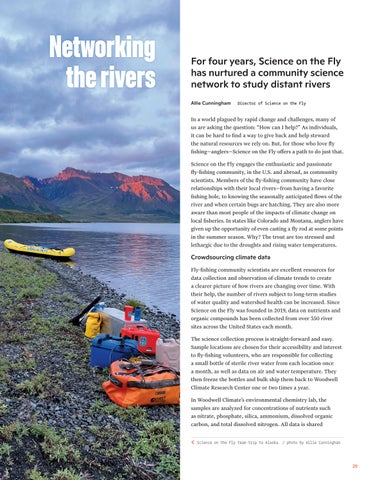Networking the rivers
For four years, Science on the Fly has nurtured a community science network to study distant rivers Allie Cunningham
Director of Science on the Fly
In a world plagued by rapid change and challenges, many of us are asking the question: “How can I help?” As individuals, it can be hard to find a way to give back and help steward the natural resources we rely on. But, for those who love fly fishing—anglers—Science on the Fly offers a path to do just that. Science on the Fly engages the enthusiastic and passionate fly-fishing community, in the U.S. and abroad, as community scientists. Members of the fly-fishing community have close relationships with their local rivers—from having a favorite fishing hole, to knowing the seasonally anticipated flows of the river and when certain bugs are hatching. They are also more aware than most people of the impacts of climate change on local fisheries. In states like Colorado and Montana, anglers have given up the opportunity of even casting a fly rod at some points in the summer season. Why? The trout are too stressed and lethargic due to the droughts and rising water temperatures. Crowdsourcing climate data Fly-fishing community scientists are excellent resources for data collection and observation of climate trends to create a clearer picture of how rivers are changing over time. With their help, the number of rivers subject to long-term studies of water quality and watershed health can be increased. Since Science on the Fly was founded in 2019, data on nutrients and organic compounds has been collected from over 350 river sites across the United States each month. The science collection process is straight-forward and easy. Sample locations are chosen for their accessibility and interest to fly-fishing volunteers, who are responsible for collecting a small bottle of sterile river water from each location once a month, as well as data on air and water temperature. They then freeze the bottles and bulk ship them back to Woodwell Climate Research Center one or two times a year. In Woodwell Climate’s environmental chemistry lab, the samples are analyzed for concentrations of nutrients such as nitrate, phosphate, silica, ammonium, dissolved organic carbon, and total dissolved nitrogen. All data is shared
Science on the Fly team trip to Alaska. / photo by Allie Cunningham Summer 2023
Climate Science for Change
29











